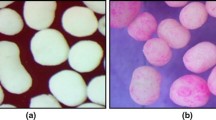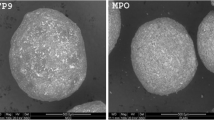Abstract
The purpose of the present study was to investigate incorporation of hydrophobic (ie, waxy) material into pellets using a thermal sintering technique and to evaluate the pellets in vitro for controlled release. Pellets prepared by extrusion-spheronization technology were formulated with a water-soluble drug, microcrystalline cellulose, and carnauba wax. Powdered carnauba wax (4%–20%) prepared by grinding or by emulsification was studied with an attempt to retard the drug release. The inclusion of ground or emulsified carnauba wax did not sustain the release of theophylline for more than 3 hours. Matrix pellets of theophylline prepared with various concentrations of carnauba wax were sintered thermally at various times and temperatures. In vitro drug release profiles indicated an increase in drug release retardation with increasing carnauba wax concentration. Pellets prepared with ground wax showed a higher standard deviation than did those prepared with emulsified wax. There was incomplete release at the end of 12 hours for pellets prepared with 20% ground or emulsified wax. The sintering temperature and duration were optimized to allow for a sustained release lasting at least 12 hours. The optimized temperature and duration were found to be 100° and 140 seconds, respectively. The sintered pellets had a higher hydrophobicity than did the unsintered pellets. Scanning electron micrographs indicated that the carnauba wax moved internally, thereby increasing the surface area of wax within the pellets.
Similar content being viewed by others
References
Sellassie IG, Gordon RH, Fawzi MB, et al. Evaluation of a high-speed pelletization process and equipment.Drug Dev Ind Pharm. 1985;11: 1523–1541.
Ghebre-Shellasie I. Pellets: a general overview. In: Ghebre-Shellasie I, ed.Pharmaceutical Pelletization Technology. New York, NY: Marcel Dekker Inc; 1989:6–7.
Vervaet C, Baert L, Remon J. Extrusion spheronisation: a literature review.Int J Pharm. 1995;116:131–146.
Rao BS, Cheruvu PS, Sudha KS, et al. Studies on release of rifampicin from sintered matrix tablets.Indian J Pharm Sci. 2001; 63:371–378.
Rao BS, Seshasayana A, Himasankar K et al. Design and evaluation of ethylene vinyl acetate sintered matrix tablets.Indian J Pharm Sci. 2003;65:496–502.
Kondaiah A, Prakash K. Design of controlled release non-erodible polymeric matrix tablets of theophylline using sintering technique.Indian J Pharm Sci. 2002;64:239–243.
Rao BS, Seshasayana A, Himasankar K, et al. Design and evaluation of eudragit RL 100 sintered matrix tablets.Indian J Pharm Sci. 2004;66:202–207.
Cohen J, Siegel RA, Langer R. Sintering technique for the preparation of polymer matrices for the controlled release of macromolecules.J Pharm Sci. 1984;73:1034–1037.
Zhou F, Vervaet C, Remon JP. Matrix pellets based on the combination of waxes, starches and maltodextrins.Int J Pharm. 1996;133:155–160.
Zhang YE, Tchao R, Schwartz JB. Effect of processing methods and heat treatment on the formation of wax matrix tablets for sustained drug release.Pharm Dev Technol. 2001;6:131–144.
Pandey VP, Kannappan N, Manavalan R, Subburaj T. Sustaining pattern of phenformin hydrochloride using various polymers and waxes.Boll Chim Farm. 2002;141:361–366.
Walia PS, Stout PJ, Turton R. Preliminary evaluation of an aqueous wax emulsion for controlled release coating.Pharm Dev Technol. 1998;3:103–113.
Huang HP, Mehta SC, Radebaugh GW, Fawzi MB. Mechanism of drug release from an acrylic polymer-wax matrix tablet.J Pharm Sci. 1994;83:795–797.
Ghaly ES, Sepulveda S.In-vitro evaluation of sustained release ibuprofen microspheres.P R Health Sci J. 1996;15:97–100.
El-Shanawany S. Sustained release of nitrofurantoin from inert wax matrices.J Control Release. 1993;26:11–19.
Kondaiah A. Design of controlled release non-erodible polymeric matrix tablets of theophylline using sintering technique.Indian J Pharm Sci. 2002;64:239–243.
Luk CL, Jane HL. Sintering in pharmaceutics. In: Swarbrick J, Boylan JC, eds.Encyclopedia of Pharmaceutical Technology. vol. 14. New York, NY: Marcel Dekker; 1996:87–101.
Mehta AM. Evaluation and characterization of pellets. In: Sellassie G, ed.Pharmaceutical Pelletization Technology. New York, NY: Marcel Dekker; 1989:241–263.
Eriksson M, Nyström C, Alderborn G. The use of air permeability for the assessment of external surface area and sphericity of pellitised granules.Int J Pharm. 1993;99:197–207.
Nasipuri RN, Omotosho JA. Influence of surfactant-treated starch on the disintegration and dissolution of sulphadiazine tablets.J Pharm Pharmacol. 1985;37:212–213.
Korsmeyer RW, Gurny R, Doelker E, Buri P, Peppas NA. Mechanisms of solute release from porous hydrophilic polymers.Int J Pharm. 1983;15:25–35.
Ritger PL, Peppas NA. A simple equation for description of solute release, II: Fickian and anomalous release from swellable devices.J Control Release. 1987;5:37–42.
Ritger PL, Peppas NA. A simple equation for description of solute release, I: Fickian and non-Fickian release from non-swellable devices in the form of slabs, spheres, cylinders or dises.J Control Release. 1987;5:23–36.
Costa P, Lobo JMS. Modeling and comparison of dissolution profiles.Eur J Pharm Sci. 2001;13:123–133.
Siepmann J, Peppas NA. Modeling of drug release from delivery systems based on hydroxypropyl methylcellulose (HPMC).Adv Drug Deliv Rev. 2001;48:139–157.
Sezer AD, Akbuga J. Controlled release of piroxicam from chitosan beads.Int J Pharm. 1995;121:113.
Gordon RE, Rosanske WT, Fonner DE, Anderson NR, Banker GS, Granulation technology and tablet characterization. In: Lieberman HA, Lachman L, Schwartz JB, eds.Pharmaceutical Dosage Forms: Tablets. New York, NY: Marcel Dekker; 1990: 245–348.
Author information
Authors and Affiliations
Corresponding author
Additional information
Published: September 14, 2007
Rights and permissions
About this article
Cite this article
Singh, R., Poddar, S.S. & Chivate, A. Sintering of wax for controlling release from pellets. AAPS PharmSciTech 8, 74 (2007). https://doi.org/10.1208/pt0803074
Received:
Revised:
Accepted:
DOI: https://doi.org/10.1208/pt0803074




